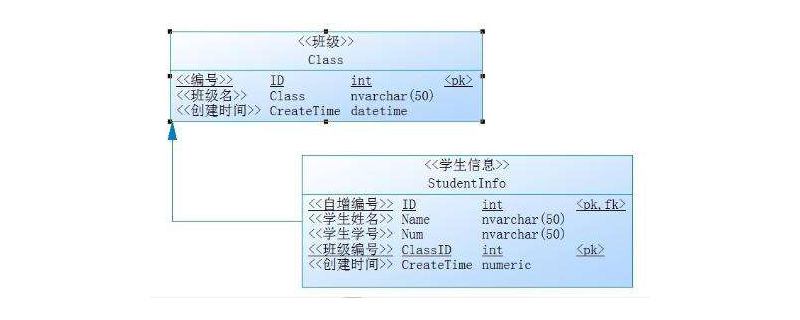What is the difference between sql primary key and foreign key
The difference between sql primary key and foreign key: 1. The primary key uniquely identifies a record, cannot be repeated, and is not allowed to be empty, while the foreign key can be repeated and can be a null value; 2. The primary key is used to maintain Data integrity, foreign keys are used to establish connections with other tables; 3. There is only one primary key, but there can be multiple foreign keys.

The difference between sql primary key and foreign key: there is only one primary key, which cannot be repeated and no null value is allowed. However, there can be multiple foreign keys, which can be repeated or not. There are null values; the primary key is used to maintain data integrity, and the foreign key is used to establish connections with other tables

What are primary keys and foreign keys
There are several attributes in a record in a relational database. If a certain attribute group (note the group) can uniquely identify a record, the attribute group can become a primary key
For example
Student table (student number, name, gender, class)
The student number of each student is unique, and the student number is a primary key
Course schedule (course Number, course name, credits)
The course number is unique, and the course number is a primary key
Grade table (student number, course number, grade)
Grade table A single attribute cannot uniquely identify a record. Only the combination of student number and course number can uniquely identify a record. Therefore, the attribute group of student number and course number is a primary key.
The student number in the score table is not the primary key of the score table. , but it corresponds to the student number in the student table, and the student number in the student table is the primary key of the student table, then the student number in the grade table is said to be the foreign key of the student table
Same as the grade table The course number in is the foreign key of the course schedule
The primary key and foreign key are defined mainly to maintain the integrity of the relational database. To summarize:
1. The primary key is the only key that can determine a record. Identification, for example, a record includes identity number, name, and age.
The ID number is the only one that can identify you. Others may be duplicated. Therefore, the ID number is the primary key.
2. Foreign keys are used to associate with another table. It is a field that can determine the record of another table and is used to maintain data consistency.
For example, if a field in table A is the primary key of table B, then it can be the foreign key of table A.
The difference between primary key and foreign key
(1) The primary key uniquely identifies a record, cannot be repeated, and is not allowed to be empty; while foreign keys can be repeated and can Is a null value
(2) The primary key is used to maintain data integrity, and the foreign key is used to establish connections with other tables
(3) There is only one primary key, and foreign keys can have Multiple
The above is the detailed content of What is the difference between sql primary key and foreign key. For more information, please follow other related articles on the PHP Chinese website!

Hot AI Tools

Undresser.AI Undress
AI-powered app for creating realistic nude photos

AI Clothes Remover
Online AI tool for removing clothes from photos.

Undress AI Tool
Undress images for free

Clothoff.io
AI clothes remover

AI Hentai Generator
Generate AI Hentai for free.

Hot Article

Hot Tools

Notepad++7.3.1
Easy-to-use and free code editor

SublimeText3 Chinese version
Chinese version, very easy to use

Zend Studio 13.0.1
Powerful PHP integrated development environment

Dreamweaver CS6
Visual web development tools

SublimeText3 Mac version
God-level code editing software (SublimeText3)

Hot Topics
 1377
1377
 52
52
 How do you alter a table in MySQL using the ALTER TABLE statement?
Mar 19, 2025 pm 03:51 PM
How do you alter a table in MySQL using the ALTER TABLE statement?
Mar 19, 2025 pm 03:51 PM
The article discusses using MySQL's ALTER TABLE statement to modify tables, including adding/dropping columns, renaming tables/columns, and changing column data types.
 Explain InnoDB Full-Text Search capabilities.
Apr 02, 2025 pm 06:09 PM
Explain InnoDB Full-Text Search capabilities.
Apr 02, 2025 pm 06:09 PM
InnoDB's full-text search capabilities are very powerful, which can significantly improve database query efficiency and ability to process large amounts of text data. 1) InnoDB implements full-text search through inverted indexing, supporting basic and advanced search queries. 2) Use MATCH and AGAINST keywords to search, support Boolean mode and phrase search. 3) Optimization methods include using word segmentation technology, periodic rebuilding of indexes and adjusting cache size to improve performance and accuracy.
 How do I configure SSL/TLS encryption for MySQL connections?
Mar 18, 2025 pm 12:01 PM
How do I configure SSL/TLS encryption for MySQL connections?
Mar 18, 2025 pm 12:01 PM
Article discusses configuring SSL/TLS encryption for MySQL, including certificate generation and verification. Main issue is using self-signed certificates' security implications.[Character count: 159]
 What are some popular MySQL GUI tools (e.g., MySQL Workbench, phpMyAdmin)?
Mar 21, 2025 pm 06:28 PM
What are some popular MySQL GUI tools (e.g., MySQL Workbench, phpMyAdmin)?
Mar 21, 2025 pm 06:28 PM
Article discusses popular MySQL GUI tools like MySQL Workbench and phpMyAdmin, comparing their features and suitability for beginners and advanced users.[159 characters]
 How do you handle large datasets in MySQL?
Mar 21, 2025 pm 12:15 PM
How do you handle large datasets in MySQL?
Mar 21, 2025 pm 12:15 PM
Article discusses strategies for handling large datasets in MySQL, including partitioning, sharding, indexing, and query optimization.
 How do you drop a table in MySQL using the DROP TABLE statement?
Mar 19, 2025 pm 03:52 PM
How do you drop a table in MySQL using the DROP TABLE statement?
Mar 19, 2025 pm 03:52 PM
The article discusses dropping tables in MySQL using the DROP TABLE statement, emphasizing precautions and risks. It highlights that the action is irreversible without backups, detailing recovery methods and potential production environment hazards.
 Difference between clustered index and non-clustered index (secondary index) in InnoDB.
Apr 02, 2025 pm 06:25 PM
Difference between clustered index and non-clustered index (secondary index) in InnoDB.
Apr 02, 2025 pm 06:25 PM
The difference between clustered index and non-clustered index is: 1. Clustered index stores data rows in the index structure, which is suitable for querying by primary key and range. 2. The non-clustered index stores index key values and pointers to data rows, and is suitable for non-primary key column queries.
 Explain different types of MySQL indexes (B-Tree, Hash, Full-text, Spatial).
Apr 02, 2025 pm 07:05 PM
Explain different types of MySQL indexes (B-Tree, Hash, Full-text, Spatial).
Apr 02, 2025 pm 07:05 PM
MySQL supports four index types: B-Tree, Hash, Full-text, and Spatial. 1.B-Tree index is suitable for equal value search, range query and sorting. 2. Hash index is suitable for equal value searches, but does not support range query and sorting. 3. Full-text index is used for full-text search and is suitable for processing large amounts of text data. 4. Spatial index is used for geospatial data query and is suitable for GIS applications.




